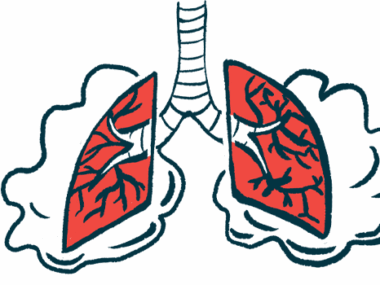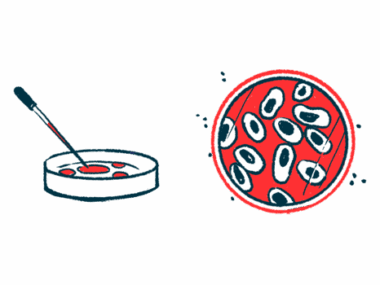Blood creatinine-to-cystatin-c ratio may track SMA treatment response
Ratio increases tied to motor function gains after long-term Spinraza treatment
Written by |

Blood creatinine-to-cystatin-c ratio, an emerging indicator of muscle mass and strength, may be a promising biomarker of therapeutic response in adults with spinal muscular atrophy (SMA), a study in China shows.
Increases in the ratio were significantly associated with gains in motor function, including improved motor skills, hand and arm abilities, and daily living activities, following long-term treatment with Spinraza (nusinersen).
“Although additional research is required to further validate our findings, the use of [creatinine-to-cystatin-c ratio] for long-term monitoring of functional changes in adult SMA patients appears highly promising,” the study’s researchers wrote. The study, “Serum creatinine to cystatin C ratio as monitoring biomarker in Chinese adult spinal muscular atrophy: a prospective cohort study,” was published in Orphanet Journal of Rare Diseases.
SMA is mainly caused by mutations in the SMN1 gene. This leads to a shortage of the SMN protein, which is essential for healthy muscle function, and results in symptoms like progressive muscle weakness and atrophy, or shrinkage.
Spinraza, which is marketed by Biogen, increases SMN levels by boosting its production from the SMN2 gene, a backup gene that produces 10%-15% of working SMN. Clinical trials show Spinraza significantly improves motor function in SMA. Still, there remains a need for “objective biomarkers … to monitor disease progression and response to therapy,” the researchers wrote.
Blood levels of creatinine, a byproduct of muscle activity, or creatine kinase (CK), released upon muscle damage, have shown correlations with SMA severity. However, these markers are influenced by kidney function, diet, or exercise, “which may limit their reliability as true indicators of muscle status.”
However, the creatinine-to-cystatin-c ratio, which is reached by dividing the level of creatinine by that of cystatin c (a biomarker of kidney function), has emerged as a more stable indicator of muscle mass and strength, and has already shown its utility in diabetes and cancer.
Responses to treatment
Here, researchers at West China Hospital of Sichuan University evaluated over 18 months the association between these blood biomarker levels and the treatment response in 28 Chinese adults with SMA receiving Spinraza. One patient had SMA type 4, while the rest had SMA type 3. More than half (57.1%) were able to walk independently. The patients’ mean age was 25.3, 57.1% were male, and the mean disease duration was 19.5 years.
Functional and motor assessments, along with blood biomarker measurements, were conducted at the study’s start and after six, 10, 14, and 18 months. The number of SMN2 gene copies was also assessed for each participant.
The results showed significant improvements in motor function, as assessed by the Hammersmith Functional Motor Scale-Expanded (HFMSE), with a mean score rising by 1.04 points at six months and reaching a 1.89-point gain by 18 months relative to the study’s start. Notably, 35.7% of patients improved their overall motor function by at least 3 points on the HFMSE, a clinical meaningful change. Most of them (80%) could walk independently at the start.
Upper limb abilities, evaluated by the Revised Upper Limb Module (RULM), also improved, with a median increase of 2 points over initial scores observed from six months, and were maintained consistently throughout the study. Gains of at least 2 points in arm and hand function were achieved by 39.3% of patients, primarily in those who were unable to walk.
Daily living abilities, as measured by the Barthel Index (BI), improved by an average of 2.5 points at 18 months compared with the scores at the study’s start, with 42.9% of patients achieving gains of at least 10 points. Half were able to walk.
In contrast, the Six-Minute Walk Test (6MWT), a standard assessment of exercise capacity, didn’t show significant changes in walking distance at any point.
Blood creatinine levels rose transiently at six months and 14 months, but showed no significant change by 18 months. CK levels showed a downward trend that wasn’t statistically significant.
“In our study, [blood creatinine] was positively correlated with baseline motor function in SMA patients,” the scientists wrote.
Evaluating creatinine-to-cystatin-c ratio with Spinraza
The creatinine-to-cystatin-c ratio increased progressively over time, with mean gains of 4.35 at six months, 5.12 at 14 months, and 6.59 at 18 months.
The fact that the creatinine-to-cystatin-c ratio was significantly elevated at 18 months, in contrast to creatinine results, indicates the ratio has “better consistency with dynamic changes in functional scores than [creatinine],” the researchers wrote.
The greatest improvements in both HFMSE and BI scores, and the creatinine-to-cystatin-c ratio, were seen in ambulant patients and those with more than three SMN2 copies. This last subgroup also showed significant gains in RULM scores at later points.
“These variations in therapeutic efficacy can be attributed to the pharmacological mechanism of [Spinraza], with SMN2 copy number being a crucial factor influencing patients’ responses to the treatment,” the researchers wrote.
After adjusting for sex, time of treatment, genetic background, and ability to walk, only the creatinine-to-cystatin-c ratio was significantly associated with changes in HFMSE, meaning that increases in it were directly linked to a better motor function over time. Neither creatinine nor CK showed significant correlations with functional outcomes after adjustment.
Spinraza was well tolerated, with no serious adverse events. Some patients had mild post-puncture headaches.
“[Spinraza] can effectively improve the motor function and activities of daily living in adult SMA patients, and [blood creatinine-to-cystatin-c ratio] can be used to dynamically monitor the functional changes during the treatment,” the researchers wrote.







